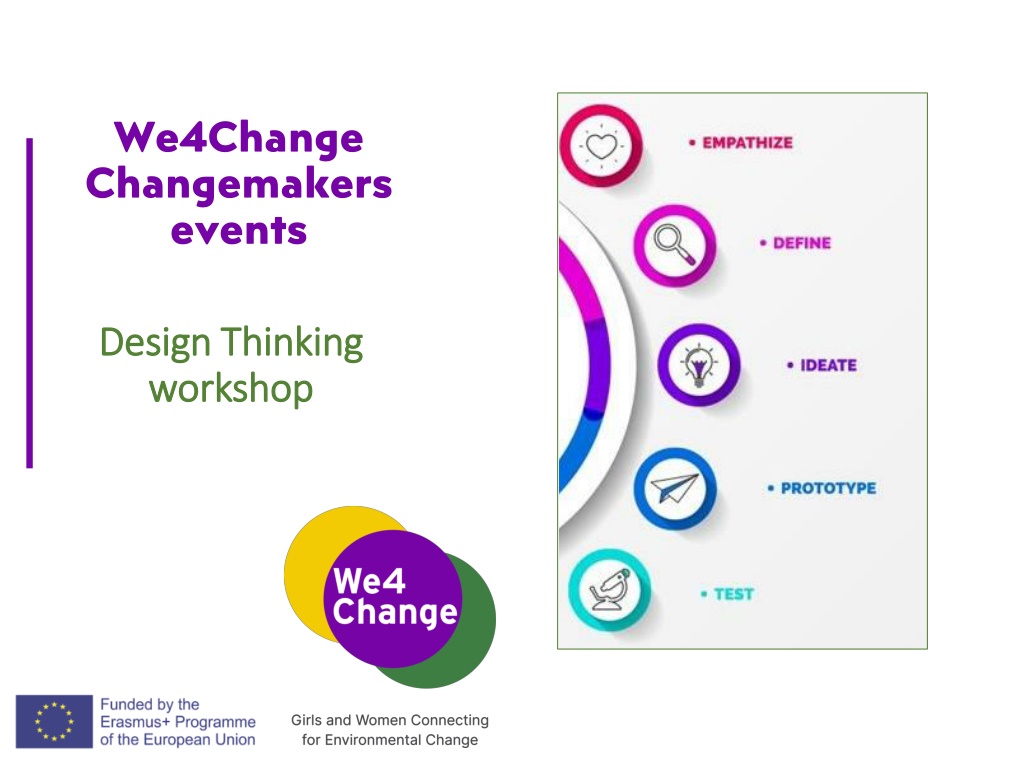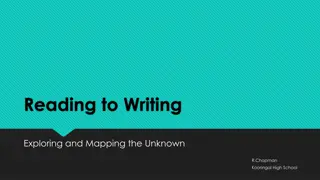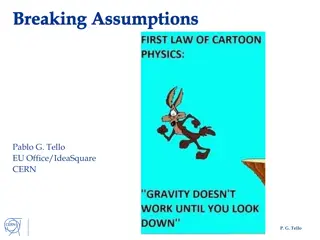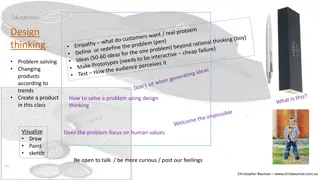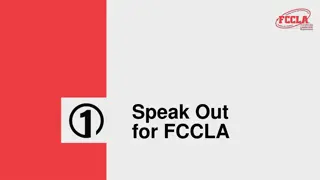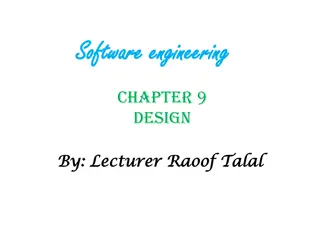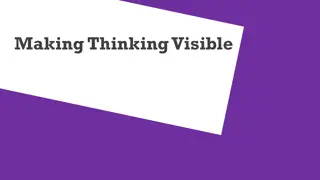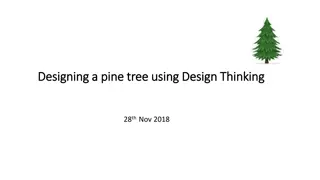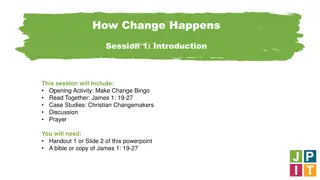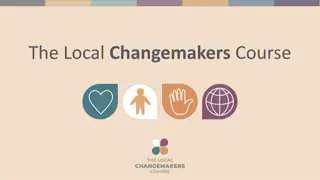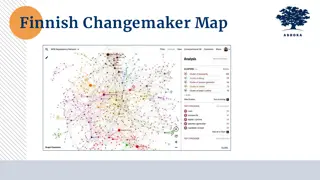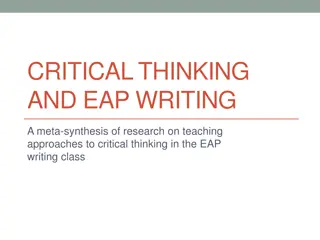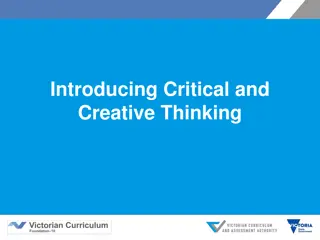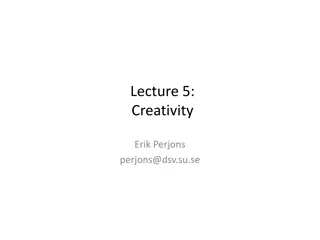Design Thinking Workshop for Changemakers
This workshop focuses on introducing Design Thinking to girls and young women from disadvantaged backgrounds, aged 15-25 years old. Through practical activities, participants enhance creativity, empathy, and critical thinking skills, aiming to create solutions to societal challenges. The workshop encourages teamwork, digital literacy, and the development of prototypes, fostering a collaborative and creative atmosphere for project ideation and testing. By combining soft skills with digital competencies, participants explore innovative approaches to address common contemporary issues.
Download Presentation

Please find below an Image/Link to download the presentation.
The content on the website is provided AS IS for your information and personal use only. It may not be sold, licensed, or shared on other websites without obtaining consent from the author.If you encounter any issues during the download, it is possible that the publisher has removed the file from their server.
You are allowed to download the files provided on this website for personal or commercial use, subject to the condition that they are used lawfully. All files are the property of their respective owners.
The content on the website is provided AS IS for your information and personal use only. It may not be sold, licensed, or shared on other websites without obtaining consent from the author.
E N D
Presentation Transcript
We4Change Changemakers events Design Thinking Design Thinking workshop workshop
Workshop schedule 25 minutes (approx.) Welcome, introduction about the workshop and its objectives, introduction to Social Innovation (SI), Social Innovation in Education (SIE), Design Thinking (DT) approach and the practical activities (Slides 3-12) 2 hours and 5 minutes (approx. 125 minutes) Applying the DT approach through 5 planned activities under specific steps (slides 13- 23) Note: Suggested duration for each practical activity with DT steps: 25 minutes (approx.), so estimated total duration of the workshop: 150 minutes. Closing of the workshop !
About this workshop: In a nutshell! Goals of workshop: introduce to participants this innovative approach and how they can solve creatively a problem, according to specific thematic areas To inspire participants to be inducted into DT process through concrete activities, promoting in parallel the project s objectives This workshop on Design Thinking is an integral part of each 1 of the 3 Changemaker Events A specific module dedicated to DT has been developed, as part of the We4Change curriculum (Output 1), which is practically tested and validated through this workshop.
Target groups and learning objectives Target group of events and of this workshop girls and young women from disadvantaged backgrounds, aged 15-25 years old Learning outcomes of this workshop: enhance female participants creativity, empathy, teamworking, digital and critical thinking skills through 5 activities improve their competence in creating prototypes or forming a new idea, under a collaborative approach reflect on their idea/ solution and test how this idea impacts the life of their users, in a creative and playful atmosphere. Combine soft skills (e.g. communication, empathy) with digital literacy to find a solution in a challenging common problem of the contemporary world, with the support and coordination of trainers
About Social Innovation (SI) What is Social Innovation? According to the Center for Social Innovation at the Stanford Graduate School of Business, SI is described as a novel solution to a social problem that is more effective, efficient, sustainable, or just than existing solutions and for which the value created accrues primarily to society as a whole rather than private individuals . SI contributes to a set of collective competences that are important for: identifying opportunities for social and collective value creation (such as empathy and responsible and critical thinking). creating collaborations and develop significant relations (such as collective and creative problem solving, embracing diversity). taking action and accomplishing collective outcomes for the benefit of society (such as collaborative planning and democratic decision making, collective efficacy).
Under the prism of SI, another familiar term has emerged, specifically the Social Innovation Education (SIE). What is SIE? A collaborative and collective learning process for the empowerment and socio/political activation of students to drive social change no matter their professional pathways . Main design principles of SIE: i) student at the centre; ii) co- creation and ii) transformative social action.
What is the connection of SI and SIE with Design Thinking approach? Design thinking (DT) is one of the most common concepts related to both co-creation and social innovation and actually a method for co-creating SI solutions. DT was first applied in the business sector as a means to increase innovation and competitiveness. However, due to its human centred approach, it has been transferred and applied in the SI domain. DT is about understanding human needs and motivations. It is a collaborative, experimental and iterative approach that requires teamwork, while the process itself is also deeply human.
Advantages of carrying out a workshop on DT Most important benefits for delivering a DT workshop: Design Thinking can be applied to all areas and fields, so a Design Thinking workshop can therefore be useful for everyone DT teaches people how to problem-solve: Problem solving is a key skill that everyone should master. A Design Thinking workshop teaches problem solving in action giving participants a tool which can be applied to almost any challenge and in any examined area . Foster innovation and teamwork: The very essence of Design Thinking lies in its collaborative vision and outside the box thinking Source (also included in the final slide with all sources): https://careerfoundry.com/en/blog/ux-design/design-thinking-workshop/
Lets explore together the DT process! What is Design Thinking ? A non-linear, iterative process that teams use to understand users, challenge assumptions, redefine problems and create innovative solutions to prototype and test Source: https://www.interaction- design.org/literature/topics/design-thinking A source to explore together visually this approach: https://www.youtube.com/watch?v=_r0VX-aU_T8
Did you ever know . what characteristics DT gathers as an approach? Human-centered approach: begins from deep empathy and understanding of needs and motivations of people Elements of the DT approach Collaborative: it benefits greatly from the views of multiple perspectives Optimistic: we all can create change no matter how big a problem, how little time or how small a budget! Experimental: designers can learn from their mistakes, because they come up with new ideas, get feedback on them and then iterate Source: IDEO (2013)
This DT workshop builds on the methodological skeleton developed by the Design department University, which proposes five phases implementing a DT process: Empathize, Define, Iterate, Prototype, of Stanford for Test. and These steps are displayed in the next image:
Activities for the DT workshop Activities for the DT workshop (practical part) (practical part) The proposed activities (next slides) are broken down in five steps: Empathize, Define, Iterate, Prototype, and Test. Even though the phases are not necessarily linear, and a certain degree of iteration is at least encouraged, the steps for this workshop are presented and analysed in a sequential way for reasons of simplicity. Total duration of the practical activities: 125 minutes (25 minutes per activity/ DT step).
Step 1: Empathize Exploring the user s needs and feelings!
Activity 1: Understand the users, their needs, and concerns Activity 1: Understand the users, their needs, and concerns Empathy is the cornerstone of any successful design project. The extent to which you understand and empathize with your users ultimately determines the outcome of your design! Aim: to navigate participants to understand the users needs and personal perspectives within the context of their design challenge. Participants should become able to empathize with their users and comprehend their emotional and physical needs. Objectives Note: Given that there are 3 different thematic areas , the user s needs will naturally differ across the area of clean energy, smart cities/mobility, and sustainable consumption. So, it depends on which topic you will select to work on! Division of participants in small groups Papers and pens for collecting ideas through brainstorming Preparation & material Internet connection to perform online research (since the idea to arrange an interview with the user seems too challenging to perform it given the specific time slot) Recommended time 25 minutes Participants will first be divided into small groups of roughly 5 persons each. The aim is to perform small brainstorming sessions or break-out rooms (can fit also in case of a virtual workshop) among participants, during which participants will be asked to discuss with each other and contemplate on the needs of their community. How research on and collect my users needs? Practical instructions Suggestion: If in-person interviews or direct observations cannot be performed in this workshop, participants can use internet sources as an alternative way to collect information about their communities needs.
Step 2: Define Define a problem statement!
Activity 2: Collectively discover the true problem ! Activity 2: Collectively discover the true problem ! Once you ve empathized with your users, you can move on to the second stage of the Design Thinking process and define the problem your users need you to solve. The Define phase, which follows empathy, involves in principle synthesizing findings in order to identify and articulate an approach to the challenge. Objectives The define stage is dedicated to defining the problem: What user problem will you be trying to solve? In other words, what is your design challenge? Additional https://www.youtube.com/watch?v=Tvu34s8iMZw (At 6:06 explains briefly this phase!) Useful materials for this step: A4 papers (for taking notes and collect all the information accumulated in the empathy stage), a whiteboard with sticky notes, marker pens, post-it notes. In the case of a virtual workshop, the same handy platform, such as Jamboard, can be deployed. 25 minutes resource to catch up quickly with the Define phase: Preparation & material Recommended time 1st step: participants will be asked to think about and write down in a white paper or a virtual panel their thoughts and insights about the following: User: Who are you designing for? Need: What does this user need? Insight: What surprised you about this user? What do you notice that nobody else notices? Participants will be given around 10 minutes to individually express their ideas. Practical instructions 2nd step: another 15-minutes brainstorming session will follow where the core ideas will be discussed and merged into a single problem statement with a brief explanation as to why the participants decided to focus on one or another particular problem. The facilitator can write each problem statement up on a whiteboard (either virtually or in a physical board) A rule of thumb: participants should focus on the user sreal emotional needs. This means that it is not necessary from now to jump to proper solutions, but mostly to grasp the essence of the problem.
Step 3: Ideate Generate ideas and potential solutions!
Activity 3: Activity 3: Time for idea generation! Time for idea generation! The goal of this activity is to encourage and support participating girls and young women to begin thinking of how to actually solve the problem they ve researched and defined. In principle, the ideate phase is when team members start to focus on the generation of creative solutions. The objective here is the quantity and diversity of ideas, not sticking to a theoretically best solution. Emphasis must be given to volume and flexibility, and eventually participants should come with as many and as different solutions as possible! Objectives Important reminder: All steps of design thinking process should be combined by creativity and teamworking, so exploring options and generating a wide variety of ideas is essential to arriving at a genuinely creative solution. For this phase, a big board is needed. The overall size of the board is essential, so as to add and display as many ideas as possible. The ideas will be written down directly in the board with a pen or posted in sticky notes (post-it notes). In case the workshop is conducted virtually, a platform like Jamboard, Miro or Mural can easily be used as alternative to the whiteboard. It is advisable that participants be kept in the same groups so as to ensure continuity with the previous steps, and ideally, they should form a cycle so everyone feels that have an equal voice. Preparation & material For the evaluation phase of the suggested ideas, a simple pen is needed to write down on the board the results. Recommended time 25 minutes In the beginning, participants will be asked by the trainer to start brainstorming and suggest as many creative ideas as they can think. The whole process should last approximately 10 . This is the creativity stage, where participants must feel unconstrained and just express freely themselves. The trainer should note down all the ideas on the board, allowing participants to get inspired simultaneously by the ideas of their peers. Upon completion of the brainstorming, participants will evaluate each idea according to following criteria: (i) feasibility of idea, (ii) cost-effectiveness of idea, and (iii) how rational the idea is, (iv) originality of idea. This is the stage where ideas are carefully reconsidered collectively. For each idea, participants can assign points for each criterion, through a process of open voting: 1 if the idea scores very poor for that criterion, and 5 if it scores very well. This method will facilitate the process and produce clear quantitative results, showcasing which idea(s) should become prototyped solutions (15 minutes). Practical instructions
Step 4: Prototype Time for building your idea!
Activity 4: The moment for the solutions prototype! Activity 4: The moment for the solution s prototype! The central objective of this phase s activity is to start creating draft and thus low-resolution prototypes of the selected solution(s) that have been ideated and voted for during the ideation step. The outcome is to give substance to the suggested solutions through a creative process, where girls and women use simple materials to embody the ideas. A prototype is nothing more than an artifact that serves as draft miniature of the solution. Objectives This means that this stage is more demanding in terms of preparation and materials. Participants are not just asked to theoretically brainstorm and produce ideas, but they must in fact use with their hands tangible materials to create a draft product of the idea. Note: useful and indicative examples are given in the curriculum s content in the DT section. This phase is the most demanding in terms of materials. Due preparation and provision of materials to participants is of outmost importance. However, the process can be kept simple and budget-friendly. In the case of physical workshop, the following materials are suggested: Cardboard/paperboard, scissor, markers, sticky tapes, plasticine, lego bricks, glue stick, colored construction papers, pens, big table(s) and anything else that is considered necessary for carrying out the phase. Preparation & material In the case of online workshop, the following materials are suggested: PowerPoint programme, Mural, Microsoft paint programme. 25 minutes 1)Participants will be divided in two or three groups. Each group will be responsible to create a prototype of the corresponding two or three most popular ideas that have been selected in Step 3. Recommended time 2) Each group will be given a maximum of 20- 25 minutes to design and create its prototype. In case of a physical meeting, each group will work on its own table, and groups should be distanced from each other for better concentration. In case of a virtual meeting, participants will be divided into break-out rooms and work on a common space platform. During the creation of prototypes, the trainer/ facilitator will monitor the groups and make interventions when needed. Practical instructions Note: If the choice of creating a model or an artifact seems to be too much complex or challenging, there are alternatives of achieving the expected outcome instead of a model s creation: 1) create a diagram (mapping of the structure, journey, process and network of participants idea); 2) Create a storyboard: i) Visualize the complete experience of your idea over time through a series of images, sketches, cartoons or even just text blocks; ii) Use Post-it Notes or individual sheets of paper to create the storyboard so you can rearrange their order. Source for the alternatives: IDEO. (2013). Design Thinking for Educators. https://f.hubspotusercontent30.net/hubfs/6474038/Design%20for%20Learning/IDEO_DTEdu_v2_toolkit+workbook.p df
Step 5: Test Testing your prototypes and gather feedback!
Activity 5: The testing phase: another chance to understand the user Activity 5: The testing phase: another chance to understand the user! ! The Testing phase is the solicitation of feedback about the prototypes that participants have created. In this way, this last phase gives them another opportunity to gain empathy for the people they are designing for. bjectives of the testing phase: (i) to refine prototypes and solutions, (ii) to learn more about their user, (iii) to refine their point of view. Objectives A rule of thumb: the final stage of design thinking is not necessarily the last thing designers will do. Remember: design thinking is an iterative process, where designers are expected to go through a series of changes, edits, and refinements. It is recommended that this step is kept as simple as possible. The most important and necessary materials that should be used for reflecting on the prototypes are: Pens, pencils, and notebooks for writing down thoughts and collecting feedback Preparation & material Coloured post-in notes *In case that upon reflection participants should return to a previous phase, the same materials that correspond to that phase can be used. 25 minutes Recommended time The process will unfold as follows: 1) The previous groups will present to each other their prototypes and afterwards they will critically provide feedback as if they were the users (under a hypothetical scenario). Participants in one group will take over the role of the design thinkers and the second group will act as the target group/users of the problem s solution. The designers team will make a brief presentation of the prototypes(s) they prepared in the previous step (5 minutes). Practical instructions 2) Upon presentation, the users team will think of the proposed idea(s) and provide feedback either for the prototype or other aspects regarding the previous steps (5 minutes). 3) Once the presenting group receives the feedback, they can devote around 15 minutes to reflect on them and refine as many points and characteristics as possible from what they have collected as feedback. Suggestion: the design thinkers team can gather easily feedback from their users by asking them and reflecting upon these questions: What worked? Wat could be improved? Any further questions ? Any other ideas?
Closing of the workshop! Reflections/ Queries
Mini glossary on the used terms: Design Thinking (DT) : a non-linear, iterative process that teams use to understand users, challenge assumptions, redefine problems and create innovative solutions to prototype and test. DT it is about a methodology that helps to solve complex problems through tangible solutions that can make an impact on other people s lives. It can help to generate innovation and contribute to creating a better and more sustainable future. Empathy: It is the ability to understand people and see the world through people's eyes, and it is to step in people's shoes to feel what they feel. Define: It is the synthesis of information you've gathered to determine a meaningful, actionable problem statement or point of view. Ideate: According to the Nielsen Norman Group, ideation is defined as the process of generating a broad set of ideas on a given topic, with no attempt to judge or evaluate them . In the ideation phase of Design Thinking process, the participants who act as designers explore and come up with as many ideas as possible.
Prototype: a physical or digital artifact that can be built with materials of different kinds. It helps designers in general to make a solution tangible in order to test it and get feedback. In DT process, Prototyping is an experimental process where design teams implement ideas into tangible forms from paper to digital. Test: User testing is part of a user-centered design process which lets the participant gain empathy for the people they are designing for by testing the prototype with them directly and understanding how they feel about it. Facilitator (the trainer of this workshop): This is a person that guides the students/ participants during project-based activities. The facilitator has the role to oversee the activities and help all participants progress through the creative process with a maieutic approach.
Useful online sources IDEO. (2013). Design Thinking for Educators. Retrieved from: https://f.hubspotusercontent30.net/hubfs/6474038/Design%20for%20Learning/IDEO_DTEdu _v2_toolkit+workbook.pdf International Design Foundation. (2021). Design Thinking. Retrieved from: https://www.interaction-design.org/literature/topics/design-thinking and https://www.interaction-design.org/literature/article/what-is-design-thinking-and-why-is-it- so-popular Interaction Design Foundation. (2021). 5 Stages in the Design Thinking Process. Retrieved from: https://www.interaction-design.org/literature/article/5-stages-in-the-design-thinking- process Interaction Design Foundation. (2021). Prototyping. Retrieved from: https://www.interaction-design.org/literature/topics/prototyping d.school. (2010). An Introduction to Design Thinking: PROCESS GUIDE. Retrieved from: https://web.stanford.edu/~mshanks/MichaelShanks/files/509554.pdf Smartsheet. (2019). The Power of Iterative Design and Process. https://www.smartsheet.com/iterative-process-guide (definition of iteration) Workshopper. (2021). Design Thinking Phase 5 - How to Test Effectively. Retrieved from: https://www.workshopper.com/post/design-thinking-phase-5-how-to-test-effectively
Stevens, E. (2021). How To Run an Awesome Design Thinking Workshop. Retrieved from: https://careerfoundry.com/en/blog/ux-design/design-thinking-workshop/ Stevens, E. (2021). What Is Empathy in Design Thinking? A Comprehensive Guide. Available at: https://careerfoundry.com/en/blog/ux-design/what-is-empathy-in-design-thinking/ Stevens, E. (2021). Stage 2 in the Design Thinking Process: Define the Problem. Available at: https://careerfoundry.com/en/blog/ux-design/stage-two-design-thinking-define-the-problem/ The Design Thinking process. An Introduction. (2021). Available at: https://www.youtube.com/watch?v=Tvu34s8iMZw QED42. How Empathy Works in Design Thinking. Retrieved from: https://www.qed42.com/blog/how-empathy-works-in-design-thinking Stephanie Baseman. Design Thinking Process. Retrieved from: https://www.stephaniebaseman.com/design-thinking-process Career Foundry. (2021). What Is Ideation in Design Thinking? An Ideation Techniques Guide. Retrieved from: https://careerfoundry.com/en/blog/ux-design/what-is-ideation-in-design-thinking/ Interaction Design Foundation. (2021). Prototyping. Retrieved from: https://www.interaction- design.org/literature/topics/prototyping Yukti. (2020). User Testing | A Beginners Guide to Stage 5 of Design Thinking Process. Retrieved from: https://www.yukti.io/stage-5-in-design-thinking-test-stage/ Mulgan, G. (2007). Social Innovation: What it is, why it matters and how it can be accelerated. Oxford, UK: Said Business School. Retrieved from: https://www.researchgate.net/publication/277873357_Social_Innovation_What_It_Is_Why_It_Matter s_and_How_It_Can_Be_Accelerated
Closing of the workshop! THANK YOU ! Now you are ready for generating new ideas with the DT method! Keep going!
